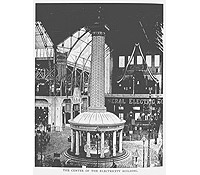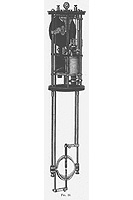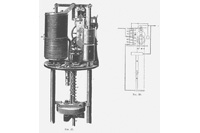Electric Lamp
Following the Industrial Revolution, expectations were raised for lighting to enable people to work even at night in a bid to increase factory operation rates. From around 1800, gas lamps employing the combustion of coal gas began to be used. While coal gas contributed to technological innovation through its use as a fuel for gas engines, the early type of internal combustion engine, gas lamps were not bright enough for people to work under.
The history of electric lamps can be traced back to arc lamps which used the discharge in gases. In 1815, H. Davy, an English chemist, succeeded in generating an intense light at the Royal Institution, conducting an experiment of an arc lamp using 2,000 Voltaic batteries as a power source. However, due to some challenges requiring improvement, such as the development of a power source for long-time supply of electricity, and the improvement of electrode spacing, the arc lamp was not put into a practical use for a while. The first use of an arc lamp following the solution to these challenges was in 1862 at Dungeness Lighthouse in England. The light of the arc lamp was extremely intense and contained many ultraviolet rays, making the lamp inappropriate for indoor use.
What drew attention for solving these problems was the incandescent lamp. Incandescent lamps were made based on the principle that when a large amount of electric current passed through a filament (fiber) in a glass bulb, the filament became incandescent and produced light. To put such lamps into a practical use, it was necessary to realize the vacuumization of the inside of the glass bulb and to prepare a filament material resistant to high temperatures.
In 1878, using a mercury vacuum pump invented by H. J. P. Sprengel, Englishman J. W. Swan developed a lamp with a carbonized cotton thread filament. In 1879, T. A. Edison, the American King of Inventors, used a carbon filament and succeeded in creating a lamp with an approximately 40-hour duration. Edison went on conducting research on the filament materials, and created a carbonized Japanese bamboo filament, attracting attention at the Paris International Electrical Exhibition of 1882. Edison was the first to apply and obtain a patent for a carbon filament lamp, compelling Swan to compete for the invention right. Subsequently, they formed a business alliance and reached a settlement.
Around the time of the Chicago International Exposition of 1893 and the fifth Paris International Exposition of 1900, incandescent lamps were used at various places in the exposition venues. They served not only for lighting but also for illumination, pleasing the eyes of many visitors.
Filament material research continued across the world. Attention was paid to tungsten powder as a material with a high melting point. In the 20th century, a gas-filled tungsten lamp was invented, leading to the development of a tungsten lamp, which is still used today.
Meanwhile, research on the discharge lamp, a progeny of the arc lamp, continued. In 1902, P. Cooper-Hewitt of the United States invented a mercury arc lamp, leading to further inventions of a neon lamp (another type of gas discharge lamp) and a fluorescent lamp (an improved version of a mercury arc lamp that formerly gave off a blue-green light and ultraviolet rays).
Electric Lamp (4 images)
 |
 |
 |
| The Edison Tower | Industrielle des Telephones' Electric Lamp | Siemens & Halske's Electric Lamp |
- References:
Iwamoto, Hiroshi.: E demiru denki no rekishi: Zuhan 300mai de monogataru denki no hakken no tabi (Omu sha, 2003) <ND21-H5>
Naokawa, Kazuya.: Denki no rekishi 2nd ed. (Tokyo denki daigaku shuppankyoku, 1994) <ND21-E48>
Takahashi, Yuzo.: Hyakumannin no denki gijutsushi (Kogyo chosakai, 2006) <ND21-H140>


